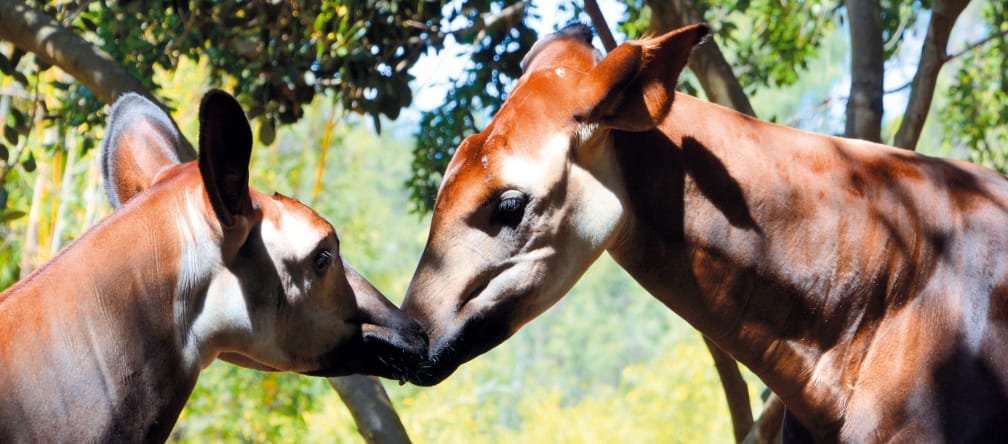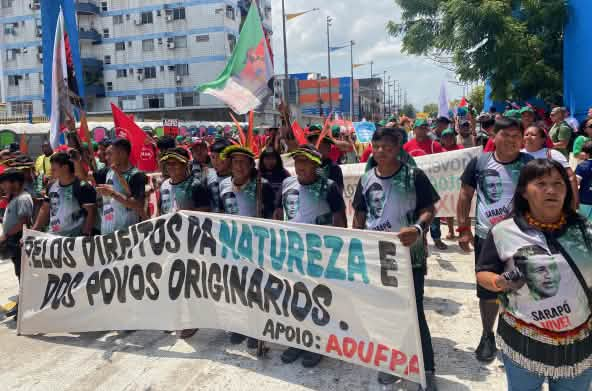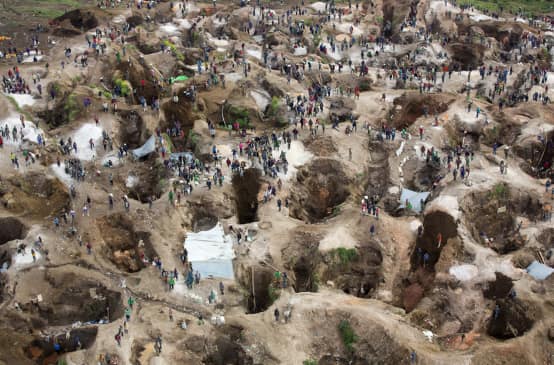
Completed campaign
Protect the world’s last okapis from gold mining!
Okapi Wildlife Reserve in the Democratic Republic of the Congo is home to a significant population of endangered okapis and chimpanzees. A UNESCO World Heritage Site since 1996, it was degraded to “in danger” status only one year later due to illegal activities. Now rampant gold mining could spell the end for the protected area.
News and updatesTo: to the President and Prime Minister of the Democratic Republic of the Congo
“Put a stop to illegal gold mining in Okapi Wildlife Reserve!”Only 30,000 okapis are left on the planet and human encroachment is steadily eating away at their habitat. 5,000 of the remaining population live in Okapi Wildlife Reserve, a protected area of nearly 670,000 hectares of mostly pristine rainforest that is also the habitat of chimpanzees and numerous other rare or endangered animals, as well as 376 species of birds.
The Democratic Republic of the Congo (DRC) – a country with one of the highest levels of biodiversity on earth – has a unique responsibility to protect its forests, also in view of their role in fighting the climate crisis.
Unfortunately, its status as a World Heritage Site is not in itself enough to protect Okapi Wildlife Reserve. Rampant illegal gold mining is destroying forests, disturbing the natural habitat of numerous plant species and wildlife, polluting waters with toxic chemicals like mercury and impacting the health of local communities and indigenous peoples. The mines are attracting outsiders in search of a livelihood into the region and causing a rise in bushmeat hunting.
In the center of the most recent case is Kimia Mining, a Chinese company based in Bunia, Ituri, that obtained illegitimate permits from the ministry of mines and is operating at a semi-industrial level within the reserve.
According to a UN report, high-ranking officers of Congo’s army FARDC are involved in the illegal mining activities. Government officials turn a blind eye as a considerable amount of the gold is smuggled across the border to Uganda. Mining is tightly connected to conflict and violence in eastern DRC.
Given the political will, protecting DRC's nature would not be difficult: The mining activities violate environmental laws and the mining code that prohibits activities harmful to nature. Furthermore, the right and duty of every Congolese citizen to protect the environment is enshrined in Article 53 of the constitution.
We therefore call on President Tshisekedi and his government to enforce the existing laws and put an end to mining in Okapi Wildlife Reserve and other protected areas.
Okapi National Park is not the only protected area in DRC threatened by resource extraction: in Virunga National Park, oil exploitation could destroy gorilla habitat, while gold mining is also a threat to Itombwe Nature Reserve. Four out of five of DRC’s World Heritages Sites are listed as “in danger”; the fifth, Salonga National Park, has just had its “in danger” status lifted following the government's announcement to end plans for oil drilling.
Further information:
Afrik21, August 11, 2021: DRC: 205 NGOs campaign for Kimia Mining’s eviction from the Okapi Wildlife Reserve
Greenpeace, August 12, 2021: Exploitation minière illégale en RDC: Greenpeace Afrique exige le retrait de l’autorisation d’exploitation de la compagnie chinoise Kimia Mining
Environews, August 9, 2021: Mines: Exploitation minière dans la Réserve de Faune à Okapi, des ONGs exigent le retrait de l’autorisation donnée à la société chinoise Kimia Mining
Reuters, June 22, 2021: Congo seizes gold worth $1.9 million in Okapi wildlife reserve
Reuters, April 11, 2020: Congo governor condemns rising insecurity at mines in gold province
FranceInfo, April 9, 2018: RDC - nouvelle vague d’arrestations de trafiquants chinois dans les mines d’or
Mining News January 10, 2017: UN urges probe of Congo officers involved in gold trafficking
ICI Radio Canada, January 9, 2017/June 18, 2019: Une enquête de l'ONU révèle l'implication de militaires congolais dans le trafic d’or
Journal Le Millénaire November 26, 2015?: CMC à Djugu, Kimia mining à Mambassa : ces chinois qui exploitent impunément l’or de l’Ituri
IPIS study: The complexity of resource governance in a context of state fragility: the case of Eastern DRC
Mongabay, June 2, 2021: Deforestation intensifies in northern DRC protected areas
Mongabay, June 18, 2021: Deforestation spikes in Virunga National Park, DRC
IUCN Red List: Okapi
UNESCO World Heritage Centre: Okapi Wildlife Reserve
NGO: Okapi Conservation Project
NGO: Impact (Canada)
Rainforest Rescue petitions:
Keep gold miners out of gorilla country! (gold mining in Itombwe)
To: to the President and Prime Minister of the Democratic Republic of the Congo
Dear Mr. President,
dear Mr. Prime Minister,
Okapi Wildlife Reserve is one of your country's natural treasures and has been recognized by UNESCO as a World Heritage Site. It is currently listed as “World Heritage in Danger” due to illegal mining and other problems.
Now, gold mining on a near-industrial scale within Okapi Wildlife Reserve by a Chinese company, Kimia Mining, is an issue of utmost urgency.
Mining operations in any form cause incalculable damage to the ecosystems. Gold exploitation within Okapi Wildlife Reserve:
- destroys tropical forests that are essential to fight the climate crisis
- disturbs the natural habitat of many plant species and wildlife
- pollutes waters with mercury and other toxic substances and
- impacts the health of local communities and the Efe and Mbuti indigenous peoples.
Mining in Okapi Wildlife Reserve and other protected areas violates Congolese environmental legislation and the mining code. No mining or quarrying rights may be granted in a protected area nor may artisanal exploitation zones be established there. Any such right granted within the confines of such areas is void.
The Democratic Republic of the Congo has committed itself to set aside more than 15% of its national territory as protected areas. To date, this quota has not yet been reached. The destruction of Okapi Wildlife Reserve would be a worrying step in the wrong direction. It would also cast doubts on DRC’s commitment to fight the climate crisis and to preserve biodiversity.
In support of 211 Congolese environmental and civil society organizations that published a statement on August 5th, we therefore kindly call on you to:
- withdraw the authorization given to the Chinese company Kimia Mining and cease issuing any mining authorizations on spaces intended for reserves and protected areas in DRC.
- prohibit any mining activity in Okapi Wildlife Reserve and surrounding areas.
- coordinate the participatory demarcation of protected area boundaries.
- seize gold from the mafia that is stealing DRC’s capital and heritage
It would be sad to see the Congolese justice system turn a blind eye to the destruction of one of your country's exceptional sites just after Salonga National Park was successfully removed from UNESCO's list of endangered World Heritage Sites.
Yours faithfully,
CC
To the Director General of ICCN in Kinshasa;
To the Diplomatic Delegation of the Republic of China;
To the Director of the BCN: National Central Bureau at Interpol Kinshasa
We are ending this petition
The okapi expert with whom we developed this petition has not been active in the region for some time. Given the current political situation in the Democratic Republic of Congo, it is extremely difficult to establish a new partnership at this point.
Although the threat to okapis remains, we are therefore ending this petition. A total of 107,343 people signed – a clear sign that we succeeded in raising awareness. We will continue to monitor developments closely, particularly the expansion of gold mining. If the threat intensifies, we are ready to launch a new campaign at any time.
Media reports in 2024 and 2025
In late 2024 and early 2025, several articles were published about the situation in the Okapi Wildlife Reserve and the gold mine operated by the company Kimia Mining.
Does a government memo announce closure?
In December 2024, the Associated Press reported that it had obtained an internal government memo from August 2024 stating that all companies in the reserve should be shut down – including Kimia Mining. However, it remains unclear when and how this will be implemented. The document had not yet been made public.
According to environmental defenders working in Congo, this represents the first acknowledgment that the current boundaries are inaccurate. Human rights and environmental groups have long emphasized that the permits issued by the Ministry of Mines were granted illegally.
The official reserve boundaries set in 1992 cover a much larger area than the maps used by the Ministry of Mines. The environmental platform Mongabay illustrates this clearly, also providing satellite images and data that show the extent of forest destruction in 2023 and 2024. Kimia Mining maintains that its operations are legal, while critics regard them as illegal.
Environmental damage from mercury
AP also reported environmental damage caused by gold mining: a 27‑year‑old woman who had worked six months for Kimia told the news agency that the soil had become barren. “It is poisoned by the chemicals used by the Chinese,” she said. AP was unable to independently verify her account.
UNESCO World Heritage in danger
Since 1997, the Okapi Wildlife Reserve has been included on the list of “UNESCO World Heritage in Danger.” Contrary to expectations from the United Nations, the government of the Democratic Republic of Congo did not provide a report on developments in 2024. “The pressure and impacts of mining activities on the property remain of significant concern,” UNESCO wrote.
Estimates suggest that within or near the reserve boundaries there are more than 40 semi‑industrial mining operations and over 18 active gold and diamond mines employing between 15,000 and 25,000 miners.

